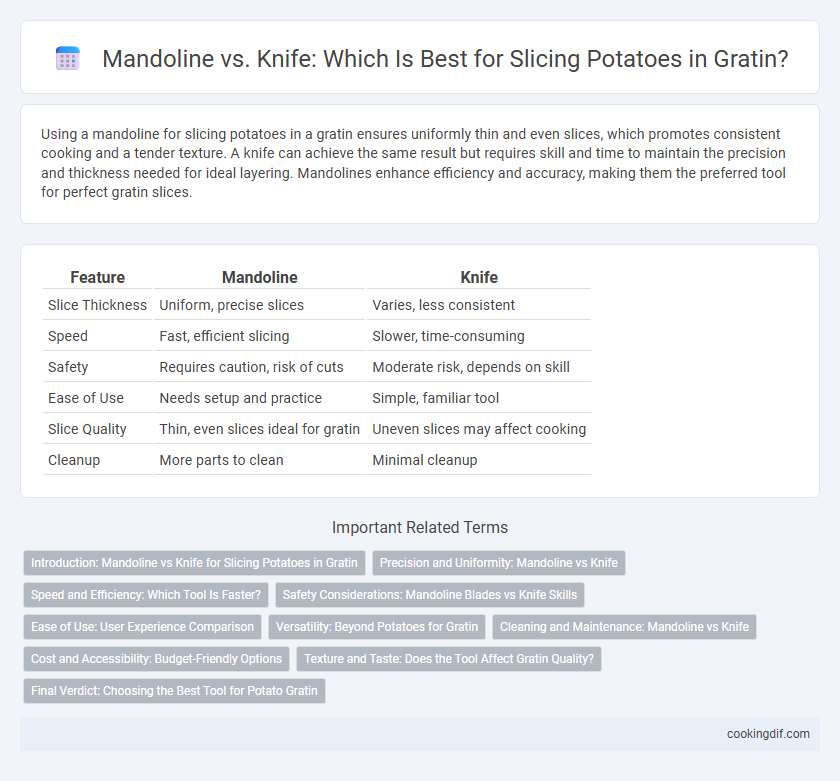Using a mandoline for slicing potatoes in a gratin ensures uniformly thin and even slices, which promotes consistent cooking and a tender texture. A knife can achieve the same result but requires skill and time to maintain the precision and thickness needed for ideal layering. Mandolines enhance efficiency and accuracy, making them the preferred tool for perfect gratin slices.
Table of Comparison
| Feature | Mandoline | Knife |
|---|---|---|
| Slice Thickness | Uniform, precise slices | Varies, less consistent |
| Speed | Fast, efficient slicing | Slower, time-consuming |
| Safety | Requires caution, risk of cuts | Moderate risk, depends on skill |
| Ease of Use | Needs setup and practice | Simple, familiar tool |
| Slice Quality | Thin, even slices ideal for gratin | Uneven slices may affect cooking |
| Cleanup | More parts to clean | Minimal cleanup |
Introduction: Mandoline vs Knife for Slicing Potatoes in Gratin
Using a mandoline for slicing potatoes in gratin ensures uniform, paper-thin slices that cook evenly and create a consistent texture. In contrast, a knife requires precise skill to achieve similar thinness, often resulting in uneven slices that affect baking time and final presentation. Mandolines improve efficiency and precision, making them the preferred tool for perfect gratin potato layers.
Precision and Uniformity: Mandoline vs Knife
A mandoline provides superior precision and uniformity when slicing potatoes for gratin, producing consistently even slices that cook evenly and enhance texture. In contrast, using a knife often results in varying thicknesses, leading to uneven cooking and less visually appealing layers. This consistency from a mandoline ensures optimal browning and a professional-quality gratin dish.
Speed and Efficiency: Which Tool Is Faster?
Using a mandoline for slicing potatoes in gratin preparation significantly increases speed and efficiency compared to a knife, delivering uniform slices in seconds. A sharp knife requires careful, slower cuts to achieve consistent thickness, which impacts cooking time and texture. Mandolines reduce prep time by producing precise, even slices quickly, enhancing overall efficiency in the kitchen.
Safety Considerations: Mandoline Blades vs Knife Skills
Mandoline blades offer precise, uniform potato slices but pose a higher risk of serious cuts due to their exposed, sharp edges, making use of safety guards and gloves essential. Knife skills require practice to achieve consistent thickness but provide more control and reduce the chance of injury with proper technique. Choosing between mandoline and knife slicing depends on balancing efficiency with the user's comfort and expertise in handling sharp tools safely.
Ease of Use: User Experience Comparison
A mandoline provides consistent, thin slices of potatoes with minimal effort, enhancing ease of use for gratin preparation. Knives require more skill and time to achieve uniform thickness, increasing the risk of uneven cooking and user fatigue. Mandolines often include safety features like hand guards, improving user experience compared to the greater precision and care needed when slicing by knife.
Versatility: Beyond Potatoes for Gratin
Mandolines offer precise and uniform slicing essential for gratin but also excel in versatility, effortlessly cutting vegetables like zucchini, carrots, and cucumbers for diverse dishes. Knives provide flexibility for uneven or thicker slices, and can handle delicate or irregular shapes with more control than mandolines. For multi-purpose kitchen tasks beyond just potatoes, combining both tools enhances efficiency and creativity in gratin and other recipes.
Cleaning and Maintenance: Mandoline vs Knife
Mandolines typically require more thorough cleaning and careful maintenance due to their multiple sharp blades and intricate parts, which can trap potato starch and increase the risk of rusting if not dried properly. In contrast, knives are generally easier to clean and maintain, often requiring just simple washing and periodic sharpening to keep the blade effective. Choosing a knife over a mandoline reduces cleaning time and lowers the risk of damage during upkeep, especially when preparing potatoes for gratin.
Cost and Accessibility: Budget-Friendly Options
Mandolines offer uniform potato slices essential for gratin but often come at a higher price point, making them less accessible for budget-conscious cooks. Knives, while requiring more skill to achieve even slices, are a cost-effective alternative readily available in most kitchens. For affordable and accessible tools, investing in a sharp chef's knife can provide satisfactory results without the additional expense of specialized equipment.
Texture and Taste: Does the Tool Affect Gratin Quality?
A mandoline slicer ensures consistently thin and uniform potato slices, which promote even baking and a creamy texture in gratin, enhancing overall taste. Knife slicing often results in uneven thickness, causing some pieces to overcook or remain undercooked, negatively impacting texture and flavor balance. Professional gratin chefs prefer mandolines for precise cuts that optimize potato softness and flavor integration.
Final Verdict: Choosing the Best Tool for Potato Gratin
Mandolines offer precise, uniform slices essential for even cooking in potato gratin, maximizing texture and flavor consistency. Knives provide greater control but may result in uneven thickness, affecting the dish's overall bake quality. For optimal potato gratin results, a mandoline is the preferred tool, ensuring professional-level presentation and uniform doneness.
Mandoline vs Knife for slicing potatoes Infographic

 cookingdif.com
cookingdif.com